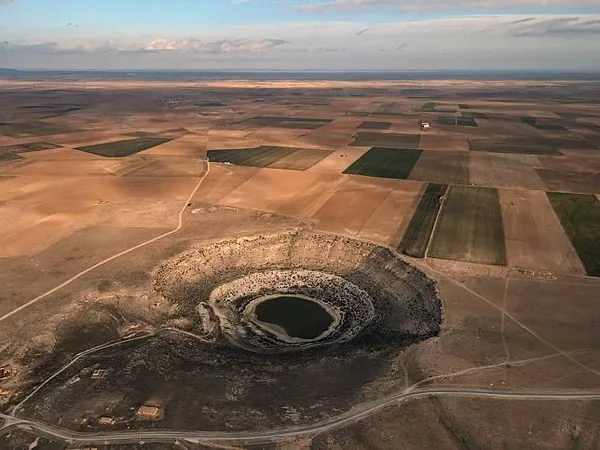
Groundbreaking Discovery: Tectonic Processes on Earth Could Hold Secrets to Other Planets!
2025-01-04
Author: Li
Introduction
The Central Anatolian Plateau, located in Turkey, is a captivating region characterized by dramatic high mountains and expansive low-relief areas. Its geological complexity has confounded scientists for decades, presenting a unique opportunity to study the dynamic forces that shape our planet's surface.
Geological Features
Rising nearly 2 kilometers above sea level, the Central Anatolian Plateau is framed by the Pontides to the north and the Taurides to the south, where stark elevation changes contrast with the plateau's more subtle interior landscape. Among its many geological features, the Konya Basin stands out as an intriguing anomaly, a circular depression that buckles the region's general trend of uplift.
Recent Research Findings
Recent research published in Nature Communications has illuminated the underlying processes at play in this enigmatic basin. Employing cutting-edge satellite technology and extensive field studies, scientists have successfully unraveled the secrets behind the Konya Basin's unusual subsidence, a phenomenon that may offer insights into tectonic activities beyond Earth.
The Konya Basin's History
The Konya Basin charted a course over millions of years, originating as a fore-arc basin during orogenic events between the Late Cretaceous and Miocene epochs. Instead of draining externally like other basins, its closed nature has allowed for the preservation of a remarkable sedimentary record, including the remnants of an ancient lake that existed until the Pleistocene epoch.
The Rate of Subsidence
Recent satellite measurements, particularly through Sentinel-1 InSAR and GNSS data, have revealed a shocking rate of subsidence in the basin—exceeding 20 millimeters per year. This rapid sinkage sharply contrasts with the overall uplift of the plateau, which has risen significantly—by as much as 1 kilometer over the last 10 million years.
Understanding the Mechanisms
Julia Andersen, a PhD candidate and the lead researcher, describes the basin's unique behavior as a "circular feature where the crust is subsiding," indicating a deep-seated connection to geological forces occurring far below the surface. Using seismic analyses, scientists have identified a seismic anomaly in the upper mantle beneath the basin, linked to dense, high-velocity materials, revealing a phenomenon known as "lithospheric dripping."
Lithospheric Dripping
Lithospheric dripping describes the process wherein heavy fragments of the Earth's crust detach and descend into the lower mantle, leading to localized surface deformations like the creation of basins. Experiments simulating this process with silicone and clay mixtures demonstrated the mechanism at work, revealing that a primary drip can initiate a series of secondary drips, each contributing to the gradual transformations of the landscape.
Broader Implications
The implications of these findings extend far beyond the Central Anatolian Plateau. Similar geophysical phenomena have been recorded in other prominent high plateaus around the globe, such as the Tibetan Plateau and the Altiplano-Puna region. Yet, the Konya Basin challenges conventional tectonic theories. Unlike the dramatic tectonic activity at its edges, the region's interior is seismically quiet, highlighting the unique mechanisms driving the basin's behavior.
Expert Insights
Professor Russell Pysklywec, a co-author of the study, emphasizes that this new insight showcases the interconnectedness of tectonic processes. “The discovery implies that significant geological events may be intertwined, and one lithospheric drip could instigate further events," he explains.
Applications to Other Planets
Moreover, researchers believe these principles could apply to other planets like Mars and Venus, both of which lack Earth-like plate tectonics. Investigating lithospheric dripping could reveal essential clues about the geological evolution of these otherworldly terrains, potentially transforming our understanding of planetary science.
Conclusion
The perplexing case of the Konya Basin, subsiding within an uplifting plateau, underscores the intricate dynamics of Earth's geology. While the plateau has seen continuous uplift, the basin's ongoing subsidence is linked to profound mantle processes rather than surface tectonics.
Geophysical Studies
Advanced geophysical studies convey the dual forces shaping the region—residual topography calculations indicate a localized depression of up to 280 meters within the basin, corroborating that heavy materials are sinking into the mantle.
Future Research Directions
As Andersen asserted, "Our findings weave together the tales of plateau uplift and basin formation, illuminating how Earth's surface reacts to the dynamics of the mantle beneath." This pioneering research not only unravels the geological secrets of Central Anatolia but also opens the door for further inquiries into tectonic processes globally. The discoveries can redefine our understanding of mountain-building and sedimentary processes, leading us to new horizons in both Earth and planetary sciences.
 Brasil (PT)
Brasil (PT)
 Canada (EN)
Canada (EN)
 Chile (ES)
Chile (ES)
 Česko (CS)
Česko (CS)
 대한민국 (KO)
대한민국 (KO)
 España (ES)
España (ES)
 France (FR)
France (FR)
 Hong Kong (EN)
Hong Kong (EN)
 Italia (IT)
Italia (IT)
 日本 (JA)
日本 (JA)
 Magyarország (HU)
Magyarország (HU)
 Norge (NO)
Norge (NO)
 Polska (PL)
Polska (PL)
 Schweiz (DE)
Schweiz (DE)
 Singapore (EN)
Singapore (EN)
 Sverige (SV)
Sverige (SV)
 Suomi (FI)
Suomi (FI)
 Türkiye (TR)
Türkiye (TR)
 الإمارات العربية المتحدة (AR)
الإمارات العربية المتحدة (AR)